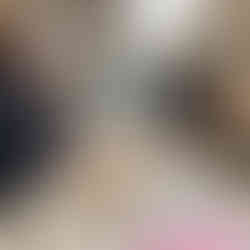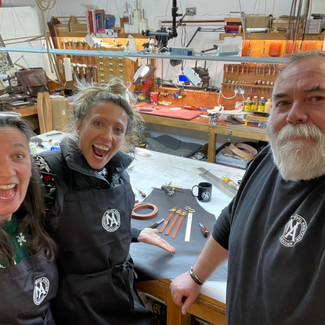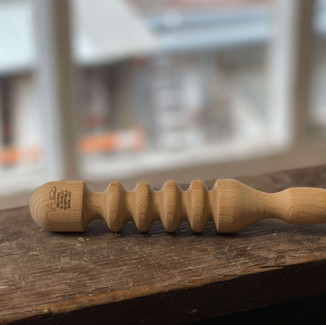In March 2021 I started working at George Barnsley and sons, with no leather craft experience whatsoever (apart from a really cool bookmark I made in the brownies... but shall we say that was a while ago) it was truly an entirely new world that I never knew existed.
As I was getting to grips with my new found role in life... printing orders from the website... taking tools to the tool room... packing orders... I couldn't help but wonder what all these tools were used for.
On March 23rd while printing my orders as usual I noticed a strange order for "8 special edition clickers awls" I can remember thinking... who on earth needs 8 clicker awls??!! Armitage Leather... so I instantly typed it into google... OH MY GOD... HE TEACHES PEOPLE?!!! This is it!!! I ran straight into my Dad's office and told him what I had found... I think he could tell from the look on my face how excited I was, I thought to myself this is it... could this be the person to show me what all these tools can do?!!!
Thankfully when I emailed Nigel he didn't run for the trees at the prospect of someone who literally knew nothing turning up to his workshop with a basket of tools and knives eager to learn... and not only did I learn... but this was actually the start of a wonderful relationship with George Barnsley and Armitage Leather leading to us improving and developing old and new tools for the modern day leather worker!
Any way... back to my beginners guide...
The first thing Nigel showed me was the importance of which knife you choose for the task in hand... and how to hold it.
It was at this point he disclosed to me that he had been buying one of our knives ( 4 1/4" Clip Point) and cutting it down for his students to use... here the 4C Knife was born ( Choppy Chop Chop Chopsie knife 4C for short)
This knife is specifically designed with beginners in mind with a short easy to control blade with an oval handle which fits comfortably in the palm of your hand, perfect for doing straight cuts free hand or with a rule!
Next up is the Clickers Knife (there is a beautiful story about this knife that Nigel loves to tell but we shall save that for another day!) The Clickers Knife is our flagship knife and has been in production since the early 1900's. Now the knife design has remained exactly the same, the only difference is that we made the handle slightly bigger in the 1980's. With a set of jaws that hold either a straight or curved blade, these blades can be interchanged whenever necessary with ease and then locked into place with the specialised ferrule system.
The curved blade that is available with this knife is perfect for cutting round templates on card or leather, the shape of the handle and length of the blade make this a perfect beginners knife.
After I had "mastered" cutting we moved onto edging and stitching... and what better way to demonstrate my newly learned skills then make an apron... so after a swift call to Metropolitan Leather I had myself a nice, shall we say, slightly intimidating piece of leather!
Pattern cutting was first, this is where I learnt the "two knife trick" Black knife for the templates... Red knife for the leather!
Then... just to kick things off I then levelled up and got my hands on a Plough Gauge, perfect for strap cutting... however quite a complicated bit of kit if you know nothing about it... luckily Nigel demonstrated and I actually enjoyed using it and was genuinely surprised how easily it cut me a nice long strip of leather!
Once the straps were cut it was time for my lesson on finishing edges and then for stitching! Lucky for me by the time I had got to this stage Nigel had already paid a visit to the factory to show the tool room team how an edge beveller is used and how to sharpen them correctly so they can be used with ease straight out of the box!
After the edge bevelling Nigel then explained to me the importance of 'sealing' an edge with burnishing gum and a burnisher... my first attempt was a little messy shall we say... less is more!!!
Then came my lesson on stitching... again something I had not participated in for a while (good old brownie guides) and my first experience using a stitching clam... unbelievably helpful... almost like having an extra pair of hands. Using modern style saddle stitch... two needles and some trusty thread, Nigel gave me step by step instructions on sewing my straps with buckles together!
After my sewing was completed I then sealed the stitching by gently "kissing the leather" with a domed faced hammer, this gave a lovely almost professional finish to my straps!
Now under no circumstances am I claiming to be any kind of leather worker... however with Nigel's help I feel I have grasped a basic understanding of the basic tools required to complete small projects and more!
With Nigel's help we have put together a Leathercraft Essentials Kit, this includes;
1 x Black Clicker Ext Knife with Curve Blade
1 x Red Clicker Ext Knife with Curve Blade
1 x 4C Utility Knife
1 x 12oz Domed Hammer
1 x 2.5" Harness Diamond Awl fitted into a Beech Saddlers Awl Handle
1 x Clicker Awl
1 x Size 1 Beech Edge Beveller
1 x Narrow Skiving Knife
1 x Edge Burnisher and Gum set
1 x Pack of 10 size 4 - 48mm long 0.82 thick Harness Needles
I would just like to add... these are not beginner tools, these are foundational tools that will serve you throughout your leather working career... they just happen to be the ones you need to start with!
So basically if your starting from scratch get yourself some tools and head to YouTube watch a couple of videos and let your imagination do the rest! (I have listed a few YouTube accounts/websites that I have found useful when digging about on the world wide web for tips)
Armitage Leather
J.H Leather
Harry Rogers
As always, if you have any questions about any of the tools I have listed then please email me at info@georgebarnsleyandsons.co.uk or call the office on 0114 272 6060
























Comentarios